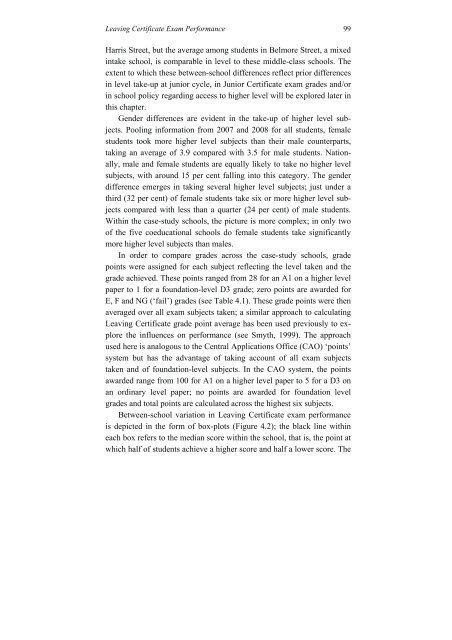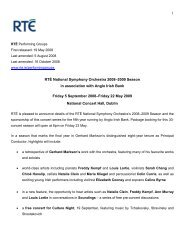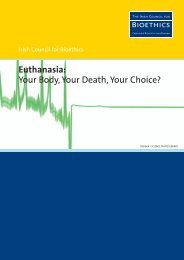From Leaving CertiFiCate to Leaving SChooL a Longitudinal Study ...
From Leaving CertiFiCate to Leaving SChooL a Longitudinal Study ...
From Leaving CertiFiCate to Leaving SChooL a Longitudinal Study ...
Create successful ePaper yourself
Turn your PDF publications into a flip-book with our unique Google optimized e-Paper software.
<strong>Leaving</strong> Certificate Exam Performance 99<br />
Harris Street, but the average among students in Belmore Street, a mixed<br />
intake school, is comparable in level <strong>to</strong> these middle-class schools. The<br />
extent <strong>to</strong> which these between-school differences reflect prior differences<br />
in level take-up at junior cycle, in Junior Certificate exam grades and/or<br />
in school policy regarding access <strong>to</strong> higher level will be explored later in<br />
this chapter.<br />
Gender differences are evident in the take-up of higher level subjects.<br />
Pooling information from 2007 and 2008 for all students, female<br />
students <strong>to</strong>ok more higher level subjects than their male counterparts,<br />
taking an average of 3.9 compared with 3.5 for male students. Nationally,<br />
male and female students are equally likely <strong>to</strong> take no higher level<br />
subjects, with around 15 per cent falling in<strong>to</strong> this category. The gender<br />
difference emerges in taking several higher level subjects; just under a<br />
third (32 per cent) of female students take six or more higher level subjects<br />
compared with less than a quarter (24 per cent) of male students.<br />
Within the case-study schools, the picture is more complex; in only two<br />
of the five coeducational schools do female students take significantly<br />
more higher level subjects than males.<br />
In order <strong>to</strong> compare grades across the case-study schools, grade<br />
points were assigned for each subject reflecting the level taken and the<br />
grade achieved. These points ranged from 28 for an A1 on a higher level<br />
paper <strong>to</strong> 1 for a foundation-level D3 grade; zero points are awarded for<br />
E, F and NG (‘fail’) grades (see Table 4.1). These grade points were then<br />
averaged over all exam subjects taken; a similar approach <strong>to</strong> calculating<br />
<strong>Leaving</strong> Certificate grade point average has been used previously <strong>to</strong> explore<br />
the influences on performance (see Smyth, 1999). The approach<br />
used here is analogous <strong>to</strong> the Central Applications Office (CAO) ‘points’<br />
system but has the advantage of taking account of all exam subjects<br />
taken and of foundation-level subjects. In the CAO system, the points<br />
awarded range from 100 for A1 on a higher level paper <strong>to</strong> 5 for a D3 on<br />
an ordinary level paper; no points are awarded for foundation level<br />
grades and <strong>to</strong>tal points are calculated across the highest six subjects.<br />
Between-school variation in <strong>Leaving</strong> Certificate exam performance<br />
is depicted in the form of box-plots (Figure 4.2); the black line within<br />
each box refers <strong>to</strong> the median score within the school, that is, the point at<br />
which half of students achieve a higher score and half a lower score. The

















